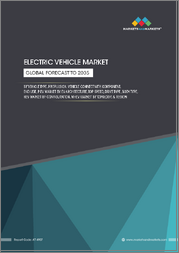
|
시장보고서
상품코드
1745110
EV 지역별 예측 - 북미EV Geographic Forecast - North America: U.S. and Canadian Light Duty Plug-In EV and EV Supply Equipment Forecasts by State, Province, and Major Metropolitan Area, 2025-2034 |
||||||
북미에서는 최근 플러그인 EV(PEV)의 판매 대수가 계속 증가하고 있어 2024년의 판매 대수는 과거 최고를 기록했습니다. 장기적인 변동으로 인해 수요가 예상보다 약해졌습니다. 그 결과 일부 자동차 제조업체는 전기화 계획을 검토했습니다. 하지만 2021년 인프라 및 고용 촉진법(Infrastructure and Jobs Act of 2021) 및 2022년 인플레이션 억제법(Inflation Reduction Act of 2022)에 의한 투자는 생산 능력 증진을 촉진하고, 배터리 팩의 비용 저하가 예상에 따라 PEV의 초기 비용 절감이 예상되기 때문에 PEV는 북미 자동차 시장에서 계속 성장할 것으로 예측됩니다.
PEV의 성장을 뒷받침하는 정책 환경은 미국의 신정권 하에서 큰 변화에 직면 할 가능성이 높습니다. 자동차, 자동차 부품, 반도체, 철강에 도입된 관세는 거의 모든 미국 무역 상대국에 대한 일반적인 관세와 함께 북미 자동차 산업에 큰 혼란을 가져올 것으로 예측됩니다.
이 보고서는 EV의 기술, 혁신, 인센티브, 정책, 차량의 가용성을 분석하고 미국과 캐나다에서 PEV의 보급을 국가, 주 또는 현, 준주 수준에서 예측했습니다. 뿐만 아니라 배터리 EV(BEV), 플러그인 하이브리드 EV(PHEV), 하이브리드 EV(HEV)의 파워트레인 구분도 포함됩니다. 레벨 1(L1), 레벨 2(L2), DC 급속 충전기), 이용 사례별(플릿, 공공시설, 집합 주택(MUD), 단독 주택(SUD), SUD 공유 주택, 직장)으로 구분되어 있습니다.
목차
제1장 주요 요약
- 소개
- 시장 예측
제2장 시장 문제
- 소개
- 시장 성장 촉진요인, 억제요인, 최신 정보
- 배터리 팩 가격
- 연료 가격
- 자동차 OEM PEV 투자
- 모델 가용성
- PEV 정책 환경
- EVSE 정책 환경
제3장 산업 밸류체인
- 경쟁 구도
- 밸류체인의 도해
- 비즈니스 모델의 진화
- 온쇼어 생산
- 공급망 통합
- 기타 주목해야 할 업계 동향
제4장 예측 조사 방법
- 차량 애널리틱스 및 시뮬레이션 툴 모델의 개요
- 장기적인 시장 점유율 : 파워트레인 간의 경쟁
- 인프라 정비와 자동차 보급의 촉진
- 자동차 판매 예측과 모델 캘리브레이션
- 지리적 특이성
- VAST 충전기 설치 모듈 개요
제5장 시장 예측
- 소개
- 미국
- PEV 예측
- EVSE 예측
- 주별 예측
- 상위 10개 도시권
- 캐나다
- PEV 예측
- EVSE 예측
- 캐나다의 주별 예측
- 상위 10개 도시권
제6장 결론 및 제안
- 3개의 큰 포인트
- 추천 사항
- 자동차 제조업체
- 정부
- 배터리 제조업체
- EVSE 공급업체, 운영자, 제조 업체
- 유틸리티
제7장 두자어 및 약어 일람
제8장 목차
제9장 도표
제10장 범위, 정보원, 조사 방법, 주석
JHS 25.06.19Sales of plug-in EVs (PEVs) have continued to increase in North America during recent years, with 2024 sales setting a new high. Despite this growth, demand was weaker than expected due to higher inflation and lingering volatility in the cost of raw materials. As a result, some automakers reevaluated their electrification plans. However, PEVs are expected to continue to be a growing piece of the North American vehicle market due to increases in production capacity spurred by investments from the Infrastructure and Jobs Act of 2021 and Inflation Reduction Act of 2022, and from an expected decrease in battery pack costs, which are likely to reduce the upfront cost of PEVs.
The policy environment that has helped PEV growth is likely to face significant change under the new U.S. administration, which has indicated plans to end policies that improve fuel efficiency as well as federal funding for PEV and EV supply equipment (EVSE) supply chains. Tariffs introduced on automobiles, auto parts, semiconductors, and steel, along with general tariffs on nearly all U.S. trading partners, are also expected to cause significant disruption to the North American auto industry.
This Guidehouse Insights report analyzes EV technology, innovations, incentives, policies, and vehicle availability to forecast PEV adoption in the U.S. and Canada on the national, state or province, and sub-state or sub-province levels. The forecasts are driven by battery pack and technology innovations, fuel prices, model availability, and zero emission vehicle (ZEV) mandates. They include passenger car and light truck segmentation in addition to powertrain breakouts by battery EVs (BEVs), plug-in hybrid EVs (PHEVs), and hybrid EVs (HEVs). Forecasts for EVSE deployments are segmented by technology (Level 1 [L1], Level 2 [L2], and DC fast chargers) and use cases, including fleet, public, multiuse dwellings (MUD), single-use dwellings (SUD), SUD-shared residences, and workplace.
Table of Contents
1. Executive Summary
- 1.1 Introduction
- 1.2 Market Forecast
2. Market Issues
- 2.1 Introduction
- 2.2 Market Drivers, Barriers, and Updates
- 2.2.1 Battery Pack Prices
- 2.2.2 Fuel Prices
- 2.2.3 Automotive OEM PEV Investment
- 2.2.4 Model Availability
- 2.2.5 PEV Policy Environment
- 2.2.5.1 Incentives
- 2.2.5.2 Regulations
- 2.2.5.3 Tariffs
- 2.2.6 EVSE Policy Environment
3. Industry Value Chain
- 3.1 Competitive Landscape
- 3.2 Pictorial Representation of the Value Chain
- 3.3 Business Model Evolution
- 3.3.1 Onshoring Production
- 3.3.2 Supply Chain Consolidation
- 3.4 Other Notable Industry Developments
4. Forecast Methodology
- 4.1 Vehicle Analytics and Simulation Tool Model Overview
- 4.1.1 Long-Run Market Share: Competition Between Powertrains
- 4.1.2 Fueling Infrastructure and Vehicle Adoption
- 4.1.3 Vehicle Sales Forecasts and Model Calibration
- 4.1.4 Geographic Specificity
- 4.2 The VAST Charger Siting Module Overview
5. Market Forecasts
- 5.1 Introduction
- 5.2 U.S.
- 5.2.1 PEV Forecasts
- 5.2.2 EVSE Forecasts
- 5.2.3 State Forecasts
- 5.2.4 Top 10 Metropolitan Areas
- 5.3 Canada
- 5.3.1 PEV Forecasts
- 5.3.2 EVSE Forecasts
- 5.3.3 Canadian Province Forecasts
- 5.3.4 Top 10 Metropolitan Areas
6. Conclusions and Recommendations
- 6.1 Three Big Takeaways
- 6.2 Recommendations
- 6.2.1 Automakers
- 6.2.2 Governments
- 6.2.3 Battery Manufacturers
- 6.2.4 EVSE Suppliers, Operators, and Manufacturers
- 6.2.5 Utilities



















